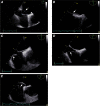Importance of Persistent Right-to-Left Shunt After Patent Foramen Ovale Closure in Cryptogenic Stroke Patients
- PMID: 33472221
- PMCID: PMC7819438
- DOI: 10.14503/THIJ-17-6582
Importance of Persistent Right-to-Left Shunt After Patent Foramen Ovale Closure in Cryptogenic Stroke Patients
Abstract
Percutaneous closure of patent foramen ovale (PFO) is widely performed to prevent recurrent stroke or transient ischemic attack in patients with cryptogenic stroke. However, the influence of different degrees of right-to-left shunting (RLS) has rarely been reported. We retrospectively evaluated the cases of 268 patients with cryptogenic stroke who underwent PFO closure at our hospital from April 2012 through April 2015. In accordance with RLS severity, we divided the patients into 2 groups: persistent RLS during normal breathing and the Valsalva maneuver (n=112) and RLS only during the Valsalva maneuver (n=156). Baseline characteristics, morphologic features, and procedural and follow-up data were reviewed. The primary endpoint was stroke or transient ischemic attack. More patients in the persistent group had multiple or bilateral ischemic lesions, as well as a larger median PFO diameter (2.5 mm [range, 1.8-3.9 mm]) than did patients in the Valsalva maneuver group (1.3 mm [range, 0.9-1.9 mm]) (P <0.001). Atrial septal aneurysm was more frequent in the persistent group: 25 patients (22.3%) compared with 18 (11.5%) (P=0.018). Three patients in the persistent group had residual shunting. The annual risk of recurrent ischemic stroke was similar between groups: 0.298% (persistent) and 0.214% (Valsalva maneuver). Our findings suggest that patients with persistent RLS have more numerous severe ischemic lesions, larger PFOs, and a higher incidence of atrial septal aneurysm than do those without. Although our persistent group had a greater risk of residual shunting after PFO closure, recurrence of ischemic events did not differ significantly from that in the Valsalva maneuver group.
Keywords: Embolism/etiology/prevention & control; foramen ovale, patent/complications/diagnostic imaging/surgery/therapy; heart atria/abnormalities/complications; ischemic attack, transient/etiology/prevention & control; recurrence; retrospective studies; risk factors; secondary prevention; stroke/prevention & control; treatment outcome.
© 2020 by the Texas Heart® Institute, Houston.
Figures
References
-
- Hagen PT, Scholz DG, Edwards WD. Incidence and size of patent foramen ovale during the first 10 decades of life: an autopsy study of 965 normal hearts. Mayo Clin Proc . 1984;59(1):17–20. - PubMed
-
- Onorato E, Casilli F. Influence of PFO anatomy on successful transcatheter closure. Interv Cardiol Clin . 2013;2(1):51–84. - PubMed
-
- McKenzie JA, Edwards WD, Hagler DJ. Anatomy of the patent foramen ovale for the interventionalist. Catheter Cardiovasc Interv . 2009;73(6):821–6. - PubMed
-
- Furlan AJ, Reisman M, Massaro J, Mauri L, Adams H, Albers GW et al. Closure or medical therapy for cryptogenic stroke with patent foramen ovale. N Engl J Med . 2012;366(11):991–9. - PubMed
-
- Carroll JD, Saver JL, Thaler DE, Smalling RW, Berry S, MacDonald LA et al. Closure of patent foramen ovale versus medical therapy after cryptogenic stroke. N Engl J Med . 2013;368(12):1092–100. - PubMed
MeSH terms
LinkOut - more resources
Full Text Sources
Medical
Miscellaneous


